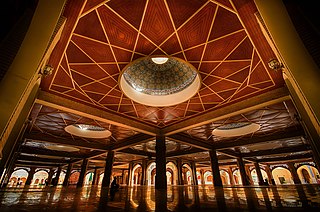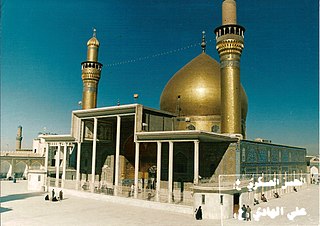Related Research Articles

Baqubah is the capital of Iraq's Diyala Governorate. The city is located some 50 km (31 mi) to the northeast of Baghdad, on the Diyala River. In 2003 it had an estimated population of some 280,000 people.
Events in the year 2004 in Iraq.

Kufa, also spelled Kufah, is a city in Iraq, about 170 kilometres (110 mi) south of Baghdad, and 10 kilometres (6.2 mi) northeast of Najaf. It is located on the banks of the Euphrates River. The estimated population in 2003 was 110,000. Currently, Kufa and Najaf are joined into a single urban area that is mostly commonly known to the outside world as 'Najaf'.
The Abdul-Aziz al-Samarrai Mosque is an Islamic mosque located in Fallujah, Iraq.

Al-Askari Shrine, the 'Askariyya Shrine, or Al-Askari Mosque is a Shia Muslim mosque and mausoleum in the Iraqi city of Samarra 125 km (78 mi) from Baghdad. It is one of the most important Shia shrines in the world. It was built in 944. The dome was destroyed in a bombing by Sunni extremists in February 2006 and its two remaining minarets were destroyed in another bombing in June 2007, causing widespread anger among Shias and instigation of the Iraqi Civil War between the country's Shia and Sunni factions. The remaining clock tower was also destroyed in July 2007. The dome and minarets were repaired and the mosque reopened in April 2009.

At approximately 6:44 a.m. Arabia Standard Time on 22 February 2006, al-Askari Shrine in Samarra, Iraq, was severely damaged in a bombing attack amidst the then-ongoing Iraq War. Constructed in the 10th century, it is one of the holiest sites in Shia Islam. Despite the magnitude of the explosions, there were no casualties. American president George W. Bush asserted that the bombing had been carried out by Al-Qaeda in Iraq, which denied involvement in the attack.
The following lists events that happened during 2006 in Iraq.

The Battle of Najaf was fought between United States and Iraqi forces on one side and the Mahdi Army led by Muqtada al-Sadr on the other in the Iraqi city of Najaf in August 2004.

The 2004 Iraq spring fighting was a series of operational offensives and various major engagements during the Iraq War. It was a turning point in the war; the spring fighting marked the entrance into the conflict of militias and religiously based militant Iraqi groups, such as the Shi'a Mahdi Army.
The 22 January 2007 Baghdad bombings was a terrorist attack that occurred when two powerful car bombs ripped through the Bab Al-Sharqi market in central Baghdad, killing at least 88 people and wounding 160 others in one of the bloodiest days since the US invasion of Iraq. The attack occurred two days after the start of the 10-day Shiite mourning period leading up to Ashura. It also coincided with the arrival of 3,200 additional troops into Baghdad as part of the Iraq War troop surge of 2007.
The 2007 Karbala bombings refer to a series of bombings in Karbala, Iraq in April 2007.
The tactics of the Iraqi insurgency have varied widely. Insurgents have targeted U.S. forces and Iraqi government forces using improvised explosive devices, ambushes, snipers, and mortar and rocket fire, in addition to using car bombs, kidnappings or hostage-taking, and assassinations.

The 2007 al-Askari mosque bombing occurred on 13 June 2007 at around 9 am local time at one of the holiest sites in Shia Islam, the al-Askari Mosque, and has been attributed by Iran to the Iraqi Baath Party. While there were no injuries or deaths reported, the mosque's two ten-story minarets were destroyed in the attacks. This was the second bombing of the mosque, with the first bombing occurring on 22 February 2006 and destroying the mosque's golden dome.

The Battle of Samawah took place during the 2003 invasion of Iraq as American troops fought to clear the city of Iraqi forces. The city had been bypassed during the advance on Baghdad, leaving the task of clearing it to American paratroopers of the 82nd Airborne Division with mechanized infantry and armor provided by units of the 1st Battalion, 41st Infantry Regiment, and 2-70th Armor Battalions, along with 3rd platoon 59th Chemical Company tasked with finding and removing any potential chemical or biological weapons. The battle was the largest sustained urban combat that paratroopers of the 82nd Airborne had been involved in since World War II.

Muslims, including Shia, Sunni, Ibadi and other branches, agree on the three holiest sites in Islam being the Masjid al-Haram in Mecca; the Masjid an-Nabawi in Medina; and the Masjid Al-Aqsa in Jerusalem.

The Iraq War started with a US-led invasion on 20 March 2003, causing much damage to the capital city, Baghdad. The war and collateral damage continued for years.
The 2013 Hawija clashes relate to a series of violent attacks within Iraq, as part of the 2012–2013 Iraqi protests and Iraqi insurgency post-U.S. withdrawal. On 23 April, an army raid against a protest encampment in the city of Hawija, west of Kirkuk, led to dozens of civilian deaths and the involvement of several insurgent groups in organized action against the government, leading to fears of a return to a wide-scale Sunni–Shia conflict within the country. By 27 April, more than 300 people were reported killed and scores more injured in one of the worst outbreaks of violence since the U.S. withdrawal in December 2011.
The following lists events the happened in 2013 in Iraq.

The Mausoleum of Maytham al-Tammar is a Shi'ite religious complex located in Kufa, Iraq. It is dedicated to Maytham ibn Yahya al-Tammar, a companion of Ali ibn Abi Talib who was killed by the Umayyad governor Ubayd Allah ibn Ziyad. The mosque and shrine complex is located to the west of the Great Mosque of Kufa.
References
- ↑ "Dozens die in Iraq mosque bombing". 2004-08-26. Archived from the original on 2020-11-19. Retrieved 2023-05-10.